AMD Radeon HD 7970 GHz Edition Review: Battling For The Performance Crown
by Ryan Smith on June 22, 2012 12:01 AM EST- Posted in
- GPUs
- AMD
- GCN
- Radeon HD 7000
OC: Power, Temperature, & Noise
Our final task is our look at the 7970GE’s overclocking capabilities. As the 7970GE is based on the existing 7970 we aren’t expecting any significant changes, however it’s reasonable to expect that general manufacturing process improvements over the last 6 months will have pushed yields and tolerances a little higher, giving us just a bit more headroom.
At the same time the presence of the boost clock and its associated voltage is going to change overclocking as well. The higher voltage should lend itself to higher overclocks, meanwhile validating overclocks is also going to be a bit harder as now we need to make sure neither the overclocked base clock/voltage combination or the overclocked boost clock/voltage combination is unstable, similar to the extra effort needed to overclock the GTX 680 series.
| Radeon HD 7970 Series Overclocking | |||||
| Ref 7970GE | Ref 7970 | XFX 7970 BEDD | |||
| Shipping Core Clock | 1000MHz | 925MHz | 1000MHz | ||
| Shipping Max Boost Clock | 1050MHz | N/A | N/A | ||
| Shipping Memory Clock | 6GHz | 5.5GHz | 5.7GHz | ||
| Shipping Max Voltage | 1.218v | 1.175v | 1.175v | ||
| Overclock Core Clock | 1150MHz | 1100MHz | 1125MHz | ||
| Overclock Max Boost Clock | 1200MHz | N/A | N/A | ||
| Overclock Memory Clock | 6.4GHz | 6.3GHz | 6.3GHz | ||
| Overclock Max Boost Voltage | 1.218v | 1.175v | 1.175v | ||
After going through the full validation process we were able to hit an overclock of +150MHz, which pushed our base clock from 1000MHz to 1150MHz, and our boost clock from 1050MHz to 1200MHz. Depending on how you want to count this overclock amidst the presence of the boost clock this is either 25MHz better than our best 7970 card, or 75MHz better. In either case our 7970GE definitely overclocks better than our earlier 7970 cards but not significantly so, which is in-line with our expectations.
As with any overclocking effort based on a single sample our overclocking results are not going to be representative of what every card can do, but they are reasonable. With AMD now binning chips for the 7970GE we’d expect to see some stratification among the 7970 family such that high overclocking chips that would previously show up in 7970 cards will now show up in 7970GE cards instead. For penny-pinching overclockers this is not good news, but for more hardcore overclockers this is nothing new as AMD’s partners have been doing something similar with their factory overclocked cards for some time now.
Meanwhile our memory overclock isn’t significantly different from what we could pull off with the reference 7970. The limitation is the memory bus or Tahiti’s memory controller, neither of which has changed. After around 6.4GHz errors start catching up and performance gains become performance losses.
Moving on to our performance charts, we’re going to once again start with power, temperature, and noise, before moving on to gaming performance. We’ll be testing our 7970 cards with the PowerTune limit set to +20% in order to avoid any real possibility of being performance limited by PowerTune.
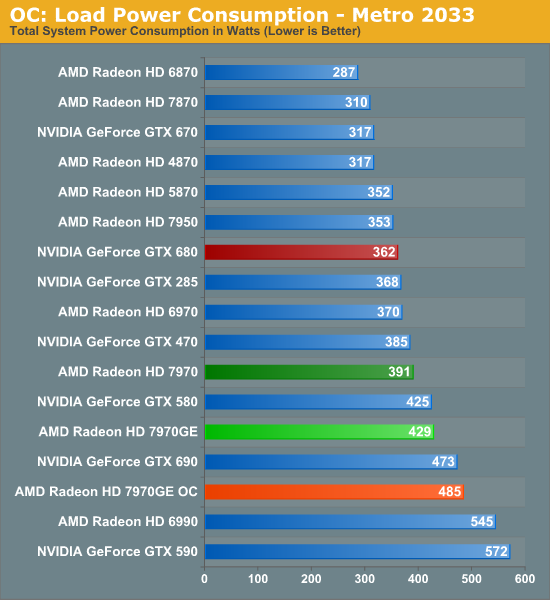
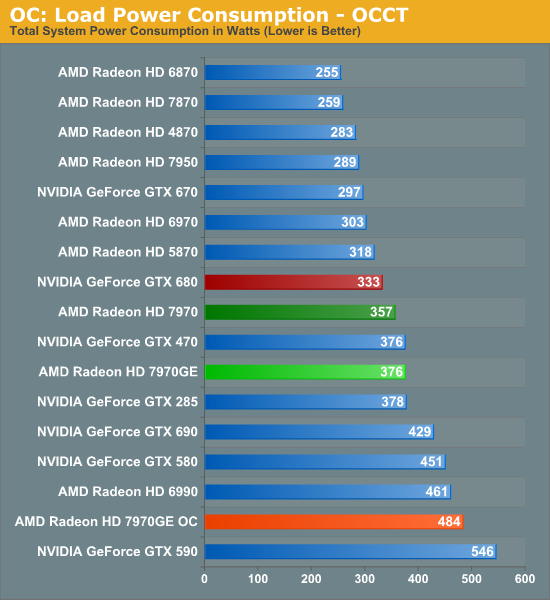
With the 7970GE’s already high load power, overclocking and raising the PowerTune limits isn’t doing it any favors when it comes to overclocking. On the contrary to being a free overclock power consumption now exceeds even the GTX 690 in all situations and power consumption is almost certainly in excess of 300W at the card level. As we’ll see in our gaming performance section we’re definitely getting more performance out of the 7970GE, but we’re paying for it with power.
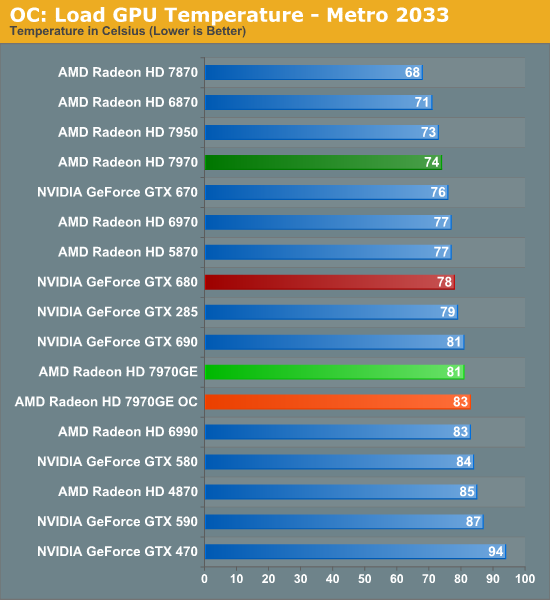
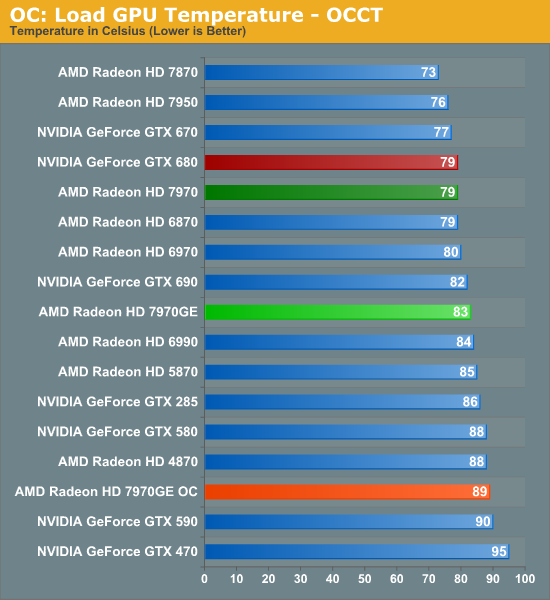
With a rise in power consumption comes a rise in temperatures to a varying degree. At 83C under Metro the 7970GE has gotten warmer, but not significantly so. The same cannot be said for OCCT. At 89C we’re approaching the reasonable limits for this card and cooler.

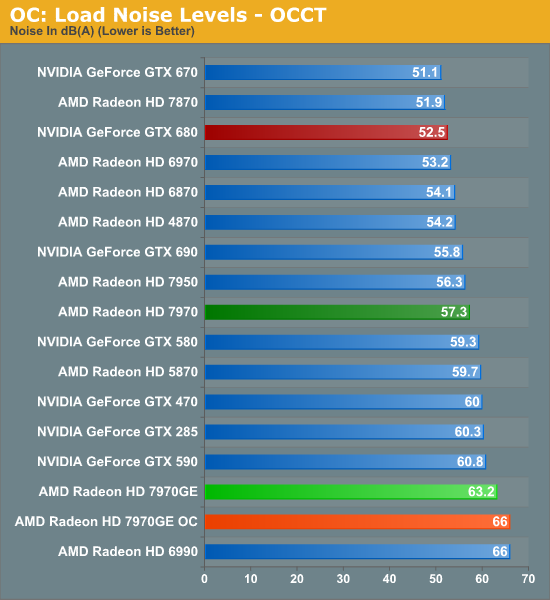
The 7970GE was already loud at stock and overclocking it doesn’t help. Under Metro noise is now at 63.8dBA, and under OCCT it’s tied with the 6990 for noise at 66dBA. Even if you’re forgiving of noise, this is reaching the point where it’s going to be difficult to ignore. Serious 7970GE overclockers will want to seek other cards and/or aftermarket coolers.










110 Comments
View All Comments
clumsyalex - Friday, June 22, 2012 - link
the first chart, the regular 7970 is priced higher than the ghz edition. the second chart shows it as lower howeverRyan Smith - Friday, June 22, 2012 - link
Actually those are a list of launch prices up top. The 7970 launched at $550, which is indeed higher than the $500 launch price of the 7970GE.EnerJi - Friday, June 22, 2012 - link
It's confusing and misleading. The first thing I thought when I saw it was that you had accidentally reversed the prices between the two models.Iketh - Friday, June 22, 2012 - link
that certainly isn't what I thought... i understood what was being presented to meCeriseCogburn - Saturday, June 23, 2012 - link
I love how amd has a birthday for tahiti at 6 months....Why wait a year for a birthday when you're a lying sack of crap corporate monster rip off crummy drivers fan boy mass brainwash co ?
Heck, two birthdays a year !!! amd is so great, they get two birthdays a year !
silverblue - Monday, June 25, 2012 - link
People in the first few months of a relationship like to mention anniversaries a lot despite the (rather obvious) point that the word denotes a yearly period. "Milestone" would be more appropriate though it does sound less glamourous and perhaps a bit pessimistic (well, in the case of relationships, anyway). Might even seem cynical.Captmorgan09 - Friday, June 22, 2012 - link
Just read the chart and it's not confusing... I did a double take the first time I glanced at it, but when I actually read it it made perfect sense. :)Ryan Smith - Friday, June 22, 2012 - link
In case it's not clear, since we have a price comparison chart at the bottom, the purpose of the prices up top is to help describe the cards. The fact that the 7970GE is listed for $500 next to the $550 7970 for example is to make it clear that it's launching at a lower price than the 7970. It helps offer some perspective on capabilities and the market segment it's designed for.That said, we can always get rid of it if it's a problem.
QChronoD - Friday, June 22, 2012 - link
Could I suggest adding when they launched on the line right above the prices? I can easily see how that is confusing, but also knowing how old each generation would be useful to see.Ryan Smith - Friday, June 22, 2012 - link
Now that's an excellent idea!